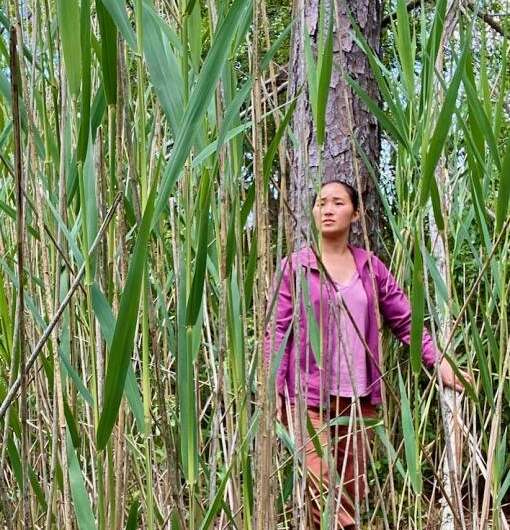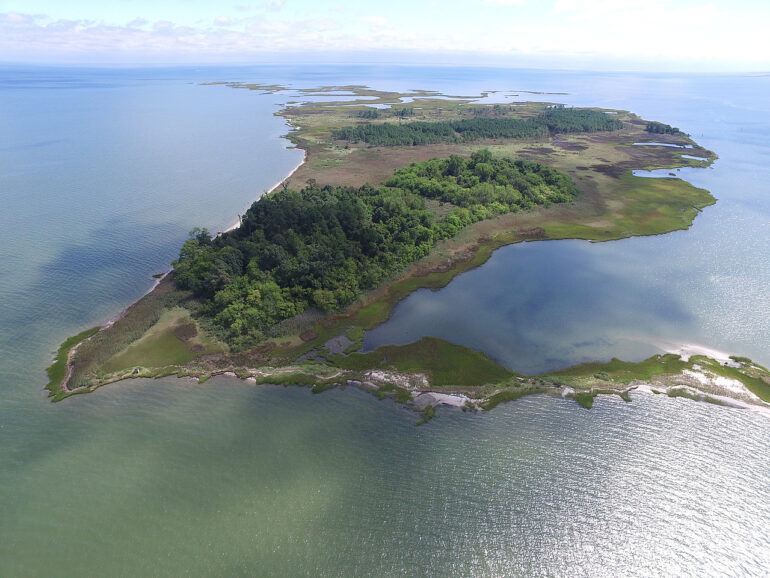Coastal ecosystems are a natural storehouse for carbon, with policymakers looking to bays, marshes, and seaside forests as nature-based solutions to help combat climate change. But the capacity of these ecosystems to take up carbon dioxide from the atmosphere depends on diverse and often conflicting factors, including sediment supply, coastal slope, tidal range, wave climate, and changes in sea level.
A recent study in Nature Communications from researchers at William & Mary’s Virginia Institute of Marine Science uses their newly developed computer model to better understand the modes and longevity of coastal carbon storage. In a key advance, the study simulates how carbon moves among coastal ecosystems as rising seas cause their boundaries and relative sizes to shift. Previous studies of coastal or “blue” carbon have largely focused on its fate within single, static habitats.
The team’s more realistic modeling of marsh dynamics reveals that the rate of sea-level rise is key to determining whether blue carbon enters a long- or short-term coastal reservoir or “sink.” Only long-term storage, on the order of centuries or millennia, will help humanity mitigate the worst effects of climate change.
Dr. Kendall Valentine, who led the study while a post-doctoral researcher at VIMS, says “Our key takeaway is that the coastal system is resilient and can continue to store increasing amounts of carbon at moderate rates of sea-level rise. But if rise rates get too fast, the marsh is unable to keep pace, the marsh system collapses, and coastal carbon storage decreases.”
Dr. Matt Kirwan, a co-author and VIMS associate professor, adds “Our research shows that sea-level rise is a double-edged sword for coastal carbon sequestration. While moderate rates of sea-level rise enhance plant productivity and carbon preservation in soils, rapid sea-level rise changes the location of carbon storage—from relatively stable forests to more vulnerable marshes.”
In addition to Kirwan, Valentine was joined on the study by former VIMS post-doctoral fellow Dr. Ellen Herbert, former student David Walters, current Ph.D. candidate Alex Smith, and post-doctoral fellow Dr. Yaping Chen.
The researchers modeled the behavior of coastal ecosystems at rates of sea-level rise ranging from 1-15 millimeters per year. Their results show that carbon storage more than doubles when the rate of sea-level rise increases from 2 to 5 mm/yr, and continues to increase at rise rates of up to 10 mm/yr. Past this “tipping point,” carbon storage begins to decline as marsh replaces forest and the seaward edge of the marsh suffers more rapid erosion.

Study co-author and VIMS post-doctoral research fellow Dr. Yaping Chen stands at the border between a saltmarsh and a seaside forest. © K. Valentine/VIMS
The team’s chosen rise-rate values bracket those now observed at sites around the world and projected for coming decades. For example, measured rates of relative sea-level rise along the U.S. East Coast in 2022 ranged from 1.49 mm/yr in Portland, Maine to 5.38 mm/yr in Norfolk, Virginia, while the 10 mm/year benchmark is being approached at a few sites along the U.S. Gulf Coast, where relative sea-level-rise rates clock in at greater than 8 mm/year. 15 mm/yr is the global rate of sea-level rise predicted in 2100 by the UN’s Intergovernmental Panel on Climate Change.
The researcher’s findings have important implications for efforts to offset greenhouse-gas emissions through purchase of carbon credits. Policies governing blue-carbon offsets—like those governing tree planting and other land-based or “green carbon” solutions—only count carbon that is captured within a particular ecosystem. This is to avoid double-counting of carbon initially captured elsewhere—say through photosynthesis in an inland forest or an offshore phytoplankton bloom—and subsequently transported to the coast.
The team’s modeling results suggest that a significant portion of marsh carbon does indeed originate outside the marsh. “Corroborating results from previous field experiments,” says Valentine, “we found that up to 50% of the carbon in marsh soils is created elsewhere.”
More information:
Kendall Valentine et al, Climate-driven tradeoffs between landscape connectivity and the maintenance of the coastal carbon sink, Nature Communications (2023). DOI: 10.1038/s41467-023-36803-7
Provided by
Virginia Institute of Marine Science
Citation:
Study: Sea-level rise is double-edged sword for carbon storage (2023, March 30)
